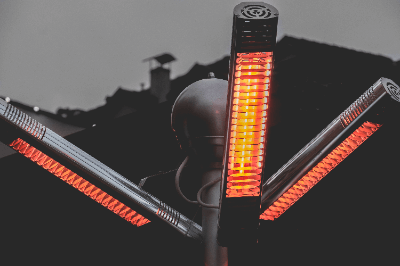What Is an Infrared Lamp?

Infrared lamps are lamps that produce infrared light by suppressing visible light.
To reduce visible light, the temperature of the filament is made lower than that of lighting lamps to generate more infrared light. Infrared light raises the surface temperature of materials, so they are used for drying and heating items, agricultural products and livestock.Some medical devices use the warming effect to relieve muscle, fatigue and nerve pain.
Shapes of infrared lamps include lamps with light bulbs or quartz tubes attached, and there are also lamps for small sensors.
Infrared Lamp Uses
For home use, infrared lamps are used in electric heating devices and fixing toner in copy machines.
Infrared lamps are warm materials, so they are also used in beautification and for medical applications such as blood circulation and perspiration, as well as in rehabilitation equipment.
Infrared lamps with halogen heaters in quartz glass tubes are often used for industrial applications. They have a wide range of applications, including drying of paint, heating of food, livestock, agriculture, in heating furnaces, as well as semiconductor manufacturing equipment.
Small infrared lamps are also used as light sources for carbon dioxide sensors, which are used to measure CO2 gas in automobiles and for gas and fire detection.
Principle of Infrared Lamps
Light bulbs emit light of various wavelengths, and those that emit more infrared wavelengths are called infrared lamps.
Infrared wavelengths vibrate molecules and generate frictional heat, which can be used to efficiently heat and dry materials in a non-contact manner.
There are three types of infrared lamps: incandescent, LED, and halogen bulbs.
1. Incandescent Bulbs
It makes use of a tungsten filament. By keeping the filament temperature of the bulb at around 2500 K, which is lower than that of a normal incandescent bulb, more infrared rays are generated. Aluminum is deposited inside the glass bulb so that infrared rays are reflected efficiently.
2. LED Light Bulbs
These bulbs are small and power-saving but have low intensity. Because of their small size, they are used as sensor components.
3. Halogen Heater (halogen lamp)
A quartz glass tube is filled with halogen and rare gases; which are both heated by a tungsten filament.
Due to the halogen effect, these lamps last longer than ordinary incandescent lamps and are more compact. They are highly efficient, emitting more than 85% of their power as infrared rays.
The Lifespan of Infrared Lamps
This section describes the life span of “halogen lamps,” which are the most widely used infrared lamps.
Halogen lamps reach the end of their life span when the tungsten used in the electrodes evaporates under the influence of usage conditions and the environment, which leads to deterioration and wear and, consequently, disconnection. Under perfect conditions, the tungsten is evaporated by the circulating halogen and regenerates at its original location, resulting in an unlimited life span, but the following factors result in a finite life span.
The first factor is the “incomplete retention” of halogen. Inside quartz tubes, halogens circulate by creating retention due to the heat generated by the tungsten. At this time, it is impossible to generate a complete circulation that returns the evaporated tungsten to its original position in the filament, and the incomplete circulation causes the tungsten to wear out and break.
The second factor is the “uneven temperature distribution” of the filament. Due to the shape of the filament and the retention of halogen, it is inevitable that the temperature distribution of the filament will be non-uniform. As a result, evaporation accelerates in the hotter parts of the filament, resulting in wire breakage and a shorter life span.
The third factor is vibration and shock. The strength of tungsten filaments, which generate heat, is reduced. Therefore, external vibrations and shock accelerate evaporation and disrupt convection currents, which in turn accelerates wear and tear and causes incomplete recirculation, resulting in a shorter life span.
Effects of Infrared Lamps
Far-infrared radiation emitted from infrared lamps has been shown to have a beneficial effect on the human body. This effect occurs when the wavelengths of far-infrared radiation pass through the skin to reach the internal parts of the body, where they warm the body from the inside by resonance with the cells.
The effect expands blood vessels promoting blood circulation, and in addition to relieving fatigue. It is also effective for coldness, stiff shoulders, and relieving of back pain. Because it warms the body from the inside, it is said to be more effective than acupuncture and moxibustion, which transmit heat from the surface of the skin.
In the field of dentistry, it has been widely used for its effectiveness in relieving muscle tension, from dry mouth massage and facial stress relief during oral treatment of facial distortion.